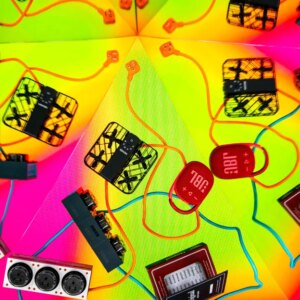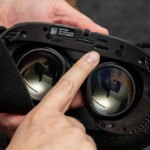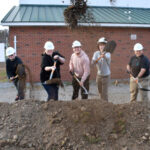Danna Freedman is searching for the early adopters.
She is the college director of the nascent MIT Quantum Initiative, or QMIT. On this new position, Freedman is giving form to an bold, Institute-wide effort to use quantum breakthroughs to essentially the most consequential challenges in science, expertise, trade, and nationwide safety.
The interdisciplinary endeavor, the latest of MIT President Sally Kornbluth’s strategic initiatives, will carry collectively MIT researchers and area consultants from a spread of industries to establish and sort out sensible challenges wherever quantum options may obtain the best influence.
“We’ve already seen how the breadth of progress in quantum has created alternatives to rethink the way forward for security and encryption, think about new modes of navigation, and even measure gravitational waves extra exactly to look at the cosmos in a completely new method,” says Freedman, the Frederick George Keyes Professor of Chemistry. “What can we do subsequent? We’re investing within the promise of quantum, and the place the legacy will probably be in 20 years.”
QMIT — the identify is a nod to the “qubit,” the fundamental unit of quantum info — will formally launch on Dec. 8 with an all-day occasion on campus. Over time, the initiative plans to determine a bodily house within the coronary heart of campus for tutorial, public, and company engagement with state-of-the-art built-in quantum methods. Past MIT’s campus, QMIT can even work carefully with the U.S. authorities and MIT Lincoln Laboratory, making use of the lab’s capabilities in quantum {hardware} improvement, methods engineering, and fast prototyping to nationwide safety priorities.
“The MIT Quantum Initiative seizes a well timed alternative in service to the nation’s scientific, financial, and technological competitiveness,” says Ian A. Waitz, MIT’s vice chairman for analysis. “With quantum capabilities approaching an inflection level, QMIT will have interaction college students and researchers throughout all our faculties and the school, in addition to corporations all over the world, in enthusiastic about what a step change in sensing and computational energy will imply for a variety of fields. Unbelievable alternatives exist in well being and life sciences, elementary physics analysis, cybersecurity, supplies science, sensing the world round us, and extra.”
Figuring out the fitting questions
Quantum phenomena are as foundational to our world as gentle or gravity. At a particularly small scale, the interactions of atoms and subatomic particles are managed by a unique algorithm than the bodily legal guidelines of the macro-sized world. These guidelines are known as quantum mechanics.
“Quantum, in a way, is what underlies all the things,” says Freedman.
By leveraging quantum properties, quantum gadgets can course of info at unimaginable pace to resolve complicated issues that aren’t possible on classical supercomputers, and to allow ultraprecise sensing and measurement. These enhancements in pace and precision will grow to be strongest when optimized in relation to particular use circumstances, and as a part of an entire quantum system. QMIT will give attention to collaboration throughout domains to co-develop quantum instruments, akin to computer systems, sensors, networks, simulations, and algorithms, alongside the supposed customers of those methods.
Because it develops, QMIT will probably be organized into programmatic pillars led by high researchers in quantum together with Paola Cappellaro, Ford Professor of Engineering and professor of nuclear science and engineering and of physics; Isaac Chuang, Julius A. Stratton Professor in Electrical Engineering and Physics; Pablo Jarillo-Herrero, Cecil and Ida Inexperienced Professor of Physics; William Oliver, Henry Ellis Warren (1894) Professor of Electrical Engineering and Pc Science and professor of physics; Vladan Vuletić, Lester Wolfe Professor of Physics; and Jonilyn Yoder, affiliate chief of the Quantum-Enabled Computation Group at MIT Lincoln Laboratory.
Whereas supporting the core of quantum analysis in physics, engineering, arithmetic, and laptop science, QMIT guarantees to broaden the group at its frontiers, into astronomy, biology, chemistry, supplies science, and drugs.
“If you happen to present a basis that anyone can combine with, that accelerates progress loads,” says Freedman. “Maybe we wish to determine how a quantum simulator we’ve constructed can mannequin photosynthesis, if that’s the fitting query — or perhaps the fitting query is to review 10 failed catalysts to see why they failed.”
“We’re going to determine what actual issues exist that we may strategy with quantum instruments, and work towards them within the subsequent 5 years,” she provides. “We’re going to change the ahead momentum of quantum in a method that helps influence.”
The MIT Quantum Initiative will probably be administratively housed within the Analysis Laboratory of Electronics (RLE), with assist from the Workplace of the Vice President for Analysis (VPR) and the Workplace of Innovation and Technique.
QMIT is a pure enlargement of MIT’s Middle for Quantum Engineering (CQE), a analysis powerhouse that engages greater than 80 principal investigators throughout the MIT campus and Lincoln Laboratory to speed up the sensible software of quantum applied sciences.
“CQE has cultivated a tremendously robust ecosystem of scholars and researchers, participating with U.S. authorities sponsors and trade collaborators, together with via the favored Quantum Annual Research Conference (QuARC) {and professional} improvement lessons,” says Marc Baldo, the Dugald C. Jackson Professor in Electrical Engineering and director of RLE.
“With the backing of former vice chairman for analysis Maria Zuber, former Lincoln Lab director Eric Evans, and Marc Baldo, we launched CQE and its trade membership group in 2019 to assist bridge MIT’s analysis efforts in quantum science and engineering,” says Oliver, CQE’s director, who additionally spent 20 years at Lincoln Laboratory, most lately as a Laboratory Fellow. “We have now an vital alternative now to deepen our dedication to quantum analysis and training, and particularly in participating college students from throughout the Institute in enthusiastic about the best way to leverage quantum science and engineering to resolve arduous issues.”
Two years in the past, Peter Fisher, the Thomas A. Frank (1977) Professor of Physics, in his position as affiliate vice chairman for analysis computing and knowledge, assembled a school group led by Cappellaro and involving Baldo, Oliver, Freedman, and others, to start to construct an initiative that may span the complete Institute. Now, capitalizing on CQE’s success, Oliver will lead the brand new MIT Quantum Initiative’s quantum computing pillar, which can broaden the work of CQE into a bigger effort that focuses on quantum computing, trade engagement, and connecting with finish customers.
The “MIT-hard” drawback
QMIT will construct upon the Institute’s historic management in quantum science and engineering. Within the spring of 1981, MIT hosted the primary Physics of Computation Conference at the Endicott House, bringing collectively almost 50 physics and computing researchers to think about the sensible promise of quantum — an mental second that’s now extensively considered the kickoff of the second quantum revolution. (The primary was the basic articulation of quantum mechanics 100 years in the past.)
Right this moment, analysis in quantum science and engineering produces a gradual stream of “firsts” within the lab and a rising variety of startup corporations.
In collaboration with companions in trade and authorities, MIT researchers develop advances in areas like quantum sensing, which includes using atomic-scale methods to measure sure properties, like distance and acceleration, with excessive precision. Quantum sensing may very well be utilized in purposes like mind imaging gadgets that seize extra element, or air visitors management methods with better positional accuracy.
One other key space of analysis is quantum simulation, which makes use of the ability of quantum computer systems to precisely emulate complicated methods. This might gasoline the invention of latest supplies for energy-efficient electronics or streamline the identification of promising molecules for drug improvement.
“Traditionally, once we take into consideration essentially the most well-articulated challenges that quantum will remedy,” Freedman says, “one of the best ones have come from within MIT. We’re open to technological options to issues, and nontraditional approaches to science. In lots of respects, we’re the early adopters.”
However she additionally attracts a pointy distinction between blue-sky enthusiastic about what quantum would possibly do, and the deeply technical, deeply collaborative work of truly drawing the roadmap. “That’s the ‘MIT-hard’ drawback,” she says.
The QMIT launch occasion on Dec. 8 will function talks and discussions that includes MIT school, together with Nobel laureates and trade leaders.















